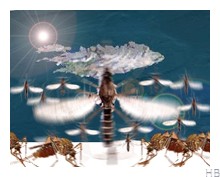Question
Why are there no mosquitos in Iceland, when they live on both sides of Greenland?
Asked By
Kjartan Magnússon
Answer
 Mosquitos, Culicidae, are true flies, Diptera, that live all over the world. Adult females suck blood from mammals, birds and in some cases reptiles, to get nutrition and proteins. Without blood intake they cannot develop eggs.
They are not found in Iceland, though they are common in neighbouring countries. There are two types in Greenland, Aedes nigripes, which can be found in all coastal regions and Aedes impiger, which is found in Northwest Greenland. In Norway there are 28 species, including Aedes nigripes. In Britain there are also 28 species, but not all the same as in Norway. In neighbouring countries to the East of Iceland, 41 species can be found.
Mosquito larvae live in water. There they feed on micro-organisms and organic material that they sieve from the water. They stay close to the surface and breathe through a siphon pipe. They often choose to live among reeds or near banks where shadows are cast on the water.
The pupae are also submerged close to the surface and breathe through a pipe. Adult mosquitos only live during the summer. Larvae also only live in the summer. Their lifecycle is short and they can have several cycles each year. In cold countries mosquitos hibernate in the pupa stage of their lifecycle, but the pupa stage is short in the summer.
All of the external conditions described above exist in Iceland. The species best suited to survival in Iceland is probably Aedes nigripes. I once found a specimen on board an Icelandair plane at Keflavík Airport. The plane had come from Narsassuaq in Greenland and was en route to Frankfurt in Germany. It is known that mosquitoes can survive in aircraft landing gear for many hours, even where the temperature goes as low as -50°C.
The reasons why mosquitoes have not colonised Iceland, and in particular the Aedes nigripes species, could be the following:
Mosquitos, Culicidae, are true flies, Diptera, that live all over the world. Adult females suck blood from mammals, birds and in some cases reptiles, to get nutrition and proteins. Without blood intake they cannot develop eggs.
They are not found in Iceland, though they are common in neighbouring countries. There are two types in Greenland, Aedes nigripes, which can be found in all coastal regions and Aedes impiger, which is found in Northwest Greenland. In Norway there are 28 species, including Aedes nigripes. In Britain there are also 28 species, but not all the same as in Norway. In neighbouring countries to the East of Iceland, 41 species can be found.
Mosquito larvae live in water. There they feed on micro-organisms and organic material that they sieve from the water. They stay close to the surface and breathe through a siphon pipe. They often choose to live among reeds or near banks where shadows are cast on the water.
The pupae are also submerged close to the surface and breathe through a pipe. Adult mosquitos only live during the summer. Larvae also only live in the summer. Their lifecycle is short and they can have several cycles each year. In cold countries mosquitos hibernate in the pupa stage of their lifecycle, but the pupa stage is short in the summer.
All of the external conditions described above exist in Iceland. The species best suited to survival in Iceland is probably Aedes nigripes. I once found a specimen on board an Icelandair plane at Keflavík Airport. The plane had come from Narsassuaq in Greenland and was en route to Frankfurt in Germany. It is known that mosquitoes can survive in aircraft landing gear for many hours, even where the temperature goes as low as -50°C.
The reasons why mosquitoes have not colonised Iceland, and in particular the Aedes nigripes species, could be the following: - They have not reached Icelandic soil from the planes they are carried by.
- If they reach Icelandic soil, then they have not found a place to lay their eggs.
- The Aedes nigripes lifecycle does not suit Icelandic conditions.
Image: HB
Um þessa spurningu
Dagsetning
Published16.12.2005
Category:
Citation
Gísli Már Gíslason. „Why are there no mosquitos in Iceland, when they live on both sides of Greenland?“. The Icelandic Web of Science 16.12.2005. http://why.is/svar.php?id=5488. (Skoðað 7.1.2026).
Author
Gísli Már Gíslasonprófessor emeritus í líffræði við HÍ



